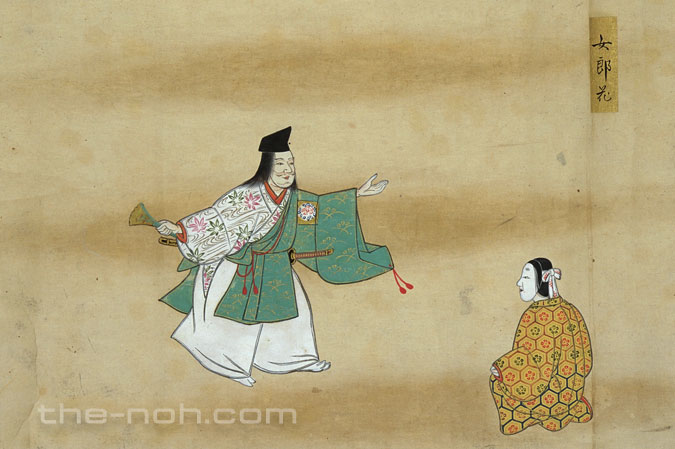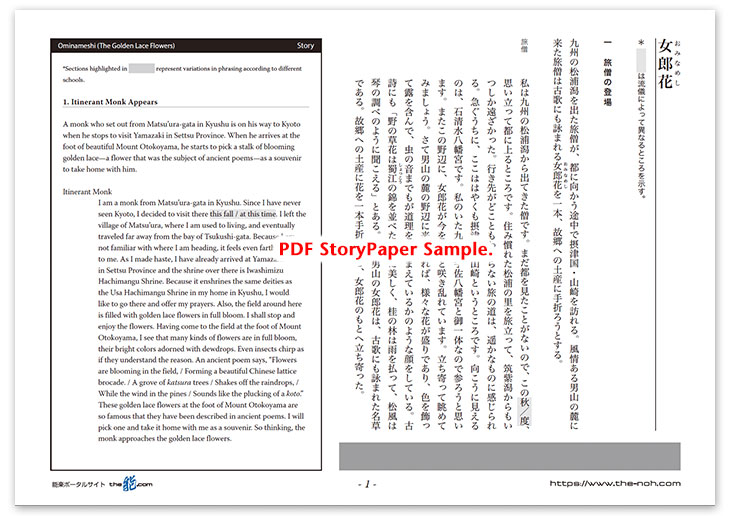
 Ominameshi (The Golden Lace Flowers)
Ominameshi (The Golden Lace Flowers)

![]()
An itinerant monk from Matsu’ura-gata in Kyushu is on his way to Kyoto when he stops by Yamazaki in Settsu Province. Finding himself in a field filled with golden lace in bloom, he starts to pick one of the flowers. Just then, an old man who is guarding the flowers appears and reproaches the monk, stopping him from picking one. While discussing poems about golden lace flowers with the old man, the monk gives up trying to take one of the flowers. However, the old man recognizes the monk’s refined sentiment and permits him to take a golden lace flower with him. Then they together go to offer their prayers at the Iwashimizu Hachimangu Shrine. The old man tells the monk that behind the mountain are located the Man’s Mound and the Woman’s Mound, which are the graves of a married couple, Ono no Yorikaze and his wife from Kyoto. After saying so, the old man vanishes into the shadow of trees under the moonlight.
A local man who resides at the foot of the mountain tells the itinerant monk a story associated with the golden lace flowers. The man suggests that the old man whom the monk just met must be the ghost of Ono no Yorikaze. At night, when the monk is performing sutra recitation, the ghosts of Yorikaze and his wife appear and reminisce about bygone days. As Yorikaze had stopped visiting his wife, she fell into such deep grief that out of spite, she drowned herself in the Hōjō River. From the mound where the wife’s body was buried, golden lace flowers started to grow. However, when Yorikaze approached the flowers, they shunned him, bending themselves away from him. Yorikaze was so saddened by this that he drowned himself in the same river, as if he were chasing after his wife. After describing himself being tortured by demons in hell for his unfaithfulness, Yorikaze expresses his desire to attain buddhahood and then vanishes into thin air.
![]()
Ghosts of a couple appear in a few other Noh plays, such as Kayoi-Komachi (Visits to Lady Komachi), Funabashi (The Floating Bridge), and Nishikigi (The Brocade Sprig of Courtship). Many of these plays were created during the early phase of Noh history. Simplicity and an air of antiquity are the common traits of these works.
In the first half of the play, the old man and the monk discuss poems with the theme of beautiful golden lace flowers and in one scene after another, they give the audience glimpses into their pride in this elegant atmosphere. In contrast to the series of tasteful, subdued scenes in the first half of the play, the mood changes dramatically in the second half, when the ghosts of Ono no Yorikaze and his wife appear. The wife first narrates her bitter resentment toward her husband, and in kakeri—the scene in which Yorikaze speaks of his suffering in hell—his strong attachment to worldly delusions is well described. This scene is the climax of this play.
Despite the dramatic contrast between the first and second halves of the play, the image of golden lace flowers consistently described throughout the entire piece lends it an atmosphere of elegance and refinement.
STORY PAPER : Ominameshi (The Golden Lace Flowers)
Story Paper presents noh chant stories in modern speech, with story outlines, highlights and more using Adobe PDF format, which can print out and zoom in. Print out the pages and take them with you when you see the actual noh performance.

The copyright of Story Paper is held by the Noh.com. Story Paper is for individual use only. It is prohibited by the copyright law to distribute or publish printed-out Story Paper pages without prior consent. For more information, check the credit and disclaimer pages.



 [Ominameshi (The Golden Lace Flowers) : Story Paper PDF : 490KB
[Ominameshi (The Golden Lace Flowers) : Story Paper PDF : 490KB